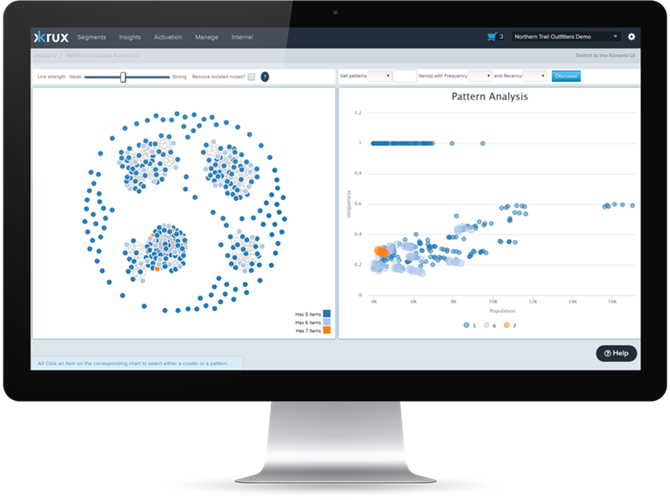Salesforce Bolsters Marketing Cloud after Krux Acquisition
Salesforce is so often in the news with its acquisitions, but it doesn’t mean that the company is wasting any time putting these new technologies to use in an effort to blow the competitors’ technologies completely out of the water. The CRM giant announced new enhancements to the Salesforce Marketing Cloud based on its recent acquisition of Krux, a data management platform (DMP), and its artificial intelligence software, Einstein.
time putting these new technologies to use in an effort to blow the competitors’ technologies completely out of the water. The CRM giant announced new enhancements to the Salesforce Marketing Cloud based on its recent acquisition of Krux, a data management platform (DMP), and its artificial intelligence software, Einstein.
The primary purpose of the enhancements is to enable marketers to collect and manage data from across the channels and devices so they can make their messages well-received by reaching out to the right audience segment. Although it sounds pretty straight forward, reaching potential customers and generating sales leads are one of the most common pain points within organizations and often, leads to a disconnection between the marketing and sales departments.
The New Enhancements
Salesforce announced two data-driven advertising tools and an Einstein Journey Insights dashboard. The first tool is cross-channel ad delivery management. This offering is powered by the Krux platform as it provides the optimal ad frequency range for marketing campaigns based on testing and measuring the engagement level of the ads. Once an optimal frequency has been reached, ads can be turned off. Detecting the optimal threshold depends on a deep understanding of prospects/customers across channels and devices. According to Salesforce, Krux interacts with more than three billion browsers and devices, supports more than 200 billion data collection events, processes more than five billion CRM records and orchestrates more than 200 billion personalized consumer experiences.
How does incorporating Krux into the Salesforce Marketing Cloud could make it any different than the other data management platform, you may ask. Krux differentiates itself from the traditional platform as it analyses and measures the engagement of customers across the different channels to make recommendations to marketers, instead of associating a cookie with an audience segment which is how traditional data management platforms work.
The second tool is the ability to target digital advertising activity by drawing from all data within Salesforce, such as data from Marketing Cloud, Commerce Cloud, Service Cloud and Sales Cloud. To put this into perspective, with this insight, a marketer can always turn off ads to a specific customer when they have a current service issue because there is nothing more impulsive than seeing a promotion about the company when you are experiencing an issue with them. However, it shouldn’t necessarily be associated with only negative activities. When you know customers purchased your product, for instance, you can turn off ads to those or you can retarget them with a campaign for complementary products. As a result, this type of targeting definitely improves customer interactions.
As I stated in my opening paragraph, the enhancements have been made also based on Einstein, so the third enhancement is an Einstein Journey Insights dashboard which uses hundreds of millions of data points to track consumer behaviors from the perspective of what leads to buying decisions so the marketer can find the most influential way of conversation. To put it into context, again, a marketer can find out that a customer who received an email first, read an article that reviews the product second, and then watched the video increases a customer’s likelihood to make a buying decision. I believe there is a strong value to understand what sequence of events leads customers to buy or not to buy the product.
Marketers can use this type of power of data to turn bad experiences around, as well. It is a very common practice with fine brands to provide a promotional coupon along with a refund when a customer returns the product due to a defect. However, now that you know what approach is the most effective, those promotional coupons can be customized.
These enhancements were announced during its Salesforce World Tour stop in New York, and Chris O'Hara, Head of Global Data Strategy at Krux said: "This is our idea of democratizing data for business users who don't have a PhD in data science." With Krux machine-learned segments, marketers can do a pattern analysis below to segment their customers into different clusters. In that way, they can target different segments for different products. Leslie Fine, Vice President of Data and Analytics at Salesforce explained how this works in reality with a brief case study during the interview with eWeek and said that Hunts Tomato Sauce, a unit of Conagra, has been using the Krux platform to target ads. However, the brand wanted to be identified as environmentally conscious because they utilize a water process instead of chemicals to remove the tomato skins, unlike their competitors. Fine said: “Their overall marketing reach was limited before the acquisition but now they’re really excited because with Salesforce they’re able to expand and leverage every sales record.”

Melissa Parrish, Sarah Sikowitz, and Susan Bidel of Forrester emphasized the importance of data management platforms like Krux in a recent Forrester report: “In 2017, marketers will integrate DMPs across their entire martech stack, providing better customer intelligence to drive decisioning from top to bottom in their marketing portfolio. Forward-leaning companies will connect this marketing brain to their enterprise CRM systems to drive better customer experiences.”
At a very simplistic level, with this type of technology on offer, sales teams can more focus on captivating relationship with the customers as they will no longer spend time on sorting the qualified leads. The same logic applied to the marketing department as they will no longer spend time on experimenting what works and what doesn’t. The implementation of artificial intelligence takes care of all these kind of respective and mundane tasks and sends actionable recommendations back.
“On average, sales reps spend 80 percent of their time qualifying leads and only 20 percent closing,” Alex Terry writes at CRM Magazine. “Qualifying leads requires advance research and many phone and email hours trying to hone in on a lead that can be turned into a sale. What if this vetting process could be done by a machine that engaged all inbound leads in an amiable, human-like way?”
If you would like to get more information on the Salesforce Marketing Cloud platform that includes marketing automation (acquired via ExactTarget in 2013), social campaign management (Buddy Media in 2012), and social listening (Radian6 in 2011) capabilities, below, Amy Martyn from Falcon-Software explaining on the CMS-Connected Show where the Salesforce Marketing Cloud formerly ExactTarget sits in the marketplace:
Timing is crucial when it comes to engaging potential buyers. This type of technology can do much better at determining the right time of what it comes into play than human beings. What we have seen here is that Salesforce has already found out how to equip marketing and sales teams so they can avoid unavailing activities to generate leads at the end of the day. And the good news is, its not just an end product as we believe we will see far more cross-over between Krux data management and Einstein AI to come. I am also inquisitive what further enhancements will be made based on other recent acquisitions and how other big players such as Oracle will respond.

Venus Tamturk
Venus is the Media Reporter for CMS-Connected, with one of her tasks to write thorough articles by creating the most up-to-date and engaging content using B2B digital marketing. She enjoys increasing brand equity and conversion through the strategic use of social media channels and integrated media marketing plans.